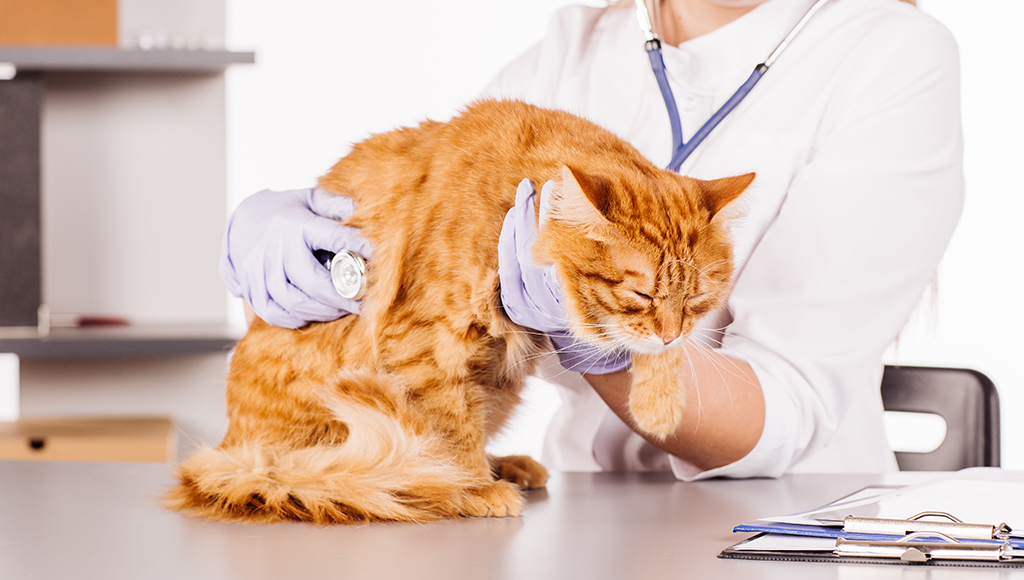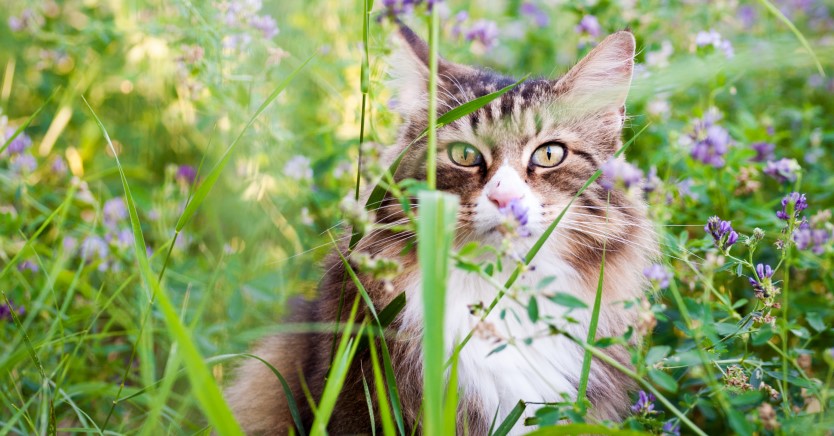Respiratory Disease in Cats
There are many possible causes of coughing and sneezing in cats. We'll help you identify some of them.

Sometimes we notice our cats coughing and sneezing. Is it something to worry about? Like humans, there could be many causes of coughing and sneezing in a cat. The coughing and sneezing may be due to environmental irritants, such as dust or allergens. Perhaps the cat’s litter is too dusty, or he/she may be allergic to something in the home or environment. Aerosol air fresheners or disinfectants may also irritate a cat’s throat if the smell is too strong or if the cat walks on wet, freshly sprayed surfaces and subsequently licks his/her paws. Check the litter and try to reduce any strong chemical scents in the air. Remember that a cat’s sense of smell is many times more sensitive than a human’s.
Most cat owners are aware of their pet’s normal daily behavior and activity level. However, how many are aware of their cat’s normal breathing pattern? A cat’s normal respiratory rate or breathing pattern may be difficult to assess, because of how well a cat can compensate and ‘hide’ disease. An owner may not even realize that their cat is having respiratory difficulties for several days. The laid-back lifestyle or the long haired coats of some cats make it difficult for some owners to assess their cat’s breathing pattern.
Do cats get colds like humans do?
Yes, cats can get upper respiratory infections or what we call the common cold or flu. However, you cannot pass a human cold to your cat and vice versa. If your cat has any of the following symptoms for more than a day or two he/she probably has an upper respiratory infection:
- Sneezing
- Runny nose
- Coughing
- Wheezing
- Discharge from the nose or mouth
- Respiratory problems
- Oral ulcers
- Conjunctivitis (discharge from the eye)
- Hypersalivation
- An abnormal or hoarse meow or lack of vocalization
If a cat is occasionally coughing or sneezing, but has no other signs of infection such as watery eyes, discharge from the nose or mouth, wheezing, lethargy, weakness, reduced appetite, or depression, you may monitor the cat for a few days to see if it improves on its own. If the coughing persists for longer than a few days, or if the condition worsens, it is best to visit your veterinarian as soon as possible.
What causes upper respiratory infections?
The cause of feline respiratory infections is usually viral. These infections are most commonly associated with two viruses: feline herpes virus, also known as feline viral rhinotracheitis, and feline calicivirus. The disease is considered mild if the cat is sneezing with the occasional nasal discharge. However, if the cat is showing open-mouthed breathing, weakness or severe coughing, this is considered severe respiratory distress and veterinary attention should be sought as soon as possible.
Are there any other causes of upper respiratory infections?
There are a wide range of possible causes for respiratory distress in cats:
- Tracheal obstructions - balls, strings, or other foreign objects may get stuck in a cat’s trachea, causing coughing and/or vomiting.
- Parasites - such as lungworm cause coughing and lethargy, although they are less common in the cat compared to other species.
- Asthma - similar to humans, severe asthmatic attacks will cause breathing problems.
- Heart disease - may cause pleural effusion (fluid accumulation around the lungs), which makes it hard for the lungs to inflate.
- Pulmonary emboli (blood clot in the lungs) - can cause inflammation in the lungs and subsequently compromise lung function.
- Allergies - allergy induced pneumonitis may cause a chronic cough.
- Viral infections, such as feline infectious peritonitis (FIP) may cause fluid build-up around the lungs due to leakage from blood vessels. Viral diseases may compromise the cat’s immune system and make them more susceptible to bacterial infection.
- Bacterial or fungal invasion of the lungs may cause pneumonia.
- Severe anemia (low red blood cell count) may also contribute to breathing difficulties.
- Cancer - tumors may occur at any location in the respiratory tract, including the nose, mouth, larynx, trachea, and lungs. Clinical signs with cancer will vary.
- Trauma - injuries, such as being hit by a car or falling, can result in a condition called pneumothorax (air in the thorax) which collapses the lungs and makes breathing difficult.
The list of possible causes for coughing and respiratory distress can be overwhelming; therefore it is best to let your veterinarian help narrow down the possibilities and pinpoint the exact cause.
How is a respiratory infection diagnosed?
Often the first diagnostic instrument that a veterinarian will use is a stethoscope. He/she will listen for abnormal lung sounds (such as fluid in the lungs), or abnormal heart sounds (indicating possible heart disease). The next step will be to get x-rays of the cat’s chest. The veterinarian will evaluate the chest for pneumonia, fluid accumulation, heart abnormalities, and any evidence of foreign bodies (such as an object stuck in the trachea), diaphragmatic hernias, or other signs of trauma.
While the cat is in clinic, the cat may be placed into a tank where it can receive oxygen to facilitate better breathing because the cat is already having difficulty breathing and most cats would be stressed coming into the clinic. If the veterinarian cannot make a clear diagnosis at this point, further diagnostics (such as an ultrasound) may be recommended depending on the findings from the x-rays.
If fluid is found within the chest, the veterinarian will collect a sample of the fluid for analysis. The fluid will be analyzed for color, opacity, protein levels and cellular content. The type of fluid will give an indication of the underlying cause of the disease, such as heart failure, tumors, infection, or leakage of chyle into the thorax.
Computed tomography (CT) scans may also be available as a diagnostic tool. It can be used in instances where ultrasound cannot provide a diagnosis, as CT technology is not impaired by air or fluid. For example, CT scans can help identify lung tumors which can be removed surgically.
If a cat is in respiratory distress due to fluid in the lungs, removing some of that fluid will provide immediate relief. The veterinarian will use a chest tap and/or chest drain. Once the cat has been stabilized, other treatments can be initiated to address the underlying problem.
The cat’s respiratory system is very delicate, and if diseased, can quickly progress to a state of emergency. Therefore, it is important to observe your cat’s normal respiratory patterns so you can recognize abnormalities before it becomes too serious.
Are there any precautionary measures to prevent future infections?
- Keep your cat indoors and away from other sick animals.
- Keep your pet in a clean environment which includes clean food and water bowls and a clean environment.
- Keep your home above 70 degrees if possible.
- If your cat gets wet, dry him off or make sure he stays warm while he dries off.
- Talk to your vet about yearly vaccinations to ward off such infections.
Ready to start saving money on pet wellness care?
Then take a look at Mint Wellness, the pet wellness plan that provides fast reimbursement on routine pet care. Save on vaccinations, wellness exams, preventatives, dental, and more!
Learn More

